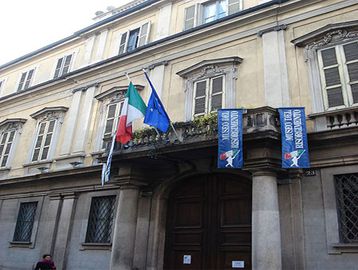

The word "Risorgimento" literally means resurrection. But historically it refers to the period of Italy's struggle for unification, for resurrection as a single state.
The unification of Italy was a long and complex process. After the fall of the Western Roman Empire in the 5th century AD many foreign states, including the Ostrogoths, the Lombards, the Byzantine Empire and later the Holy Roman Empire and Spain, all contended for domination of the Italian peninsula. Only the Republic of Venice remained an independent entity until the late 18th century, when it was incorporated into Austria. This contention between foreign powers resulted in the fragmentation of the peninsula, with the small local governments furthering the interests of their foreign protectors. People started speaking about uniting the separate Italian states under one central government already in the 13th century and the idea was vital in the writings of the Florentine humanists such as Dante Alighieri, Francesco Petrarca, Boccaccio and Niccolo Machiavelli. However, there were still many obstacles: not all the Italian city-states wanted to unite into a single government and obviously the foreign powers that controlled most of those states did not want to renounce their sovereignty over them. It was only in the 19th century that the independent Kingdom of Savoy, with Turin as its capital, created a political and military strategy to liberate Lombardy and Venice from the Austrians, the southern Kingdom of Two Sicilies from the Bourbons and then Rome from the Pope and unite them all under one flag. The first uprisings against the Austrians in the north and the Bourbons in the south occurred in 1821 and Italy was proclaimed an independent kingdom in 1861. It took another ten years, however, to wrestle Rome from the pope.
The Museum of the Risorgimento is housed in the Moriggia Palace, which was designed in 1775 by Milan's leading architect at the time, Giuseppe Piermarini. During Napoleon's reign over Lombardy the palace was the residence of the Foreign Affairs Ministry and later the Defense Ministry. Originally, the museum was opened in the Sforza Castle, but during the 1943 Allied Bombing of the city the collection was moved to the house of Alessandro Manzoni, Milan's favorite writer. Only after the war, in 1951, did the collection find its permanent home in the Moriggia Palace.
Inside we can find prints, paintings, documents, weapons and relics related to the period between Napoleon's first Italian Campaign of 1796 and Italy's annexation of Rome in 1870. Special attention is given to the Five Days of Milan rebellion against the Austrians in 1848, Italy's three Independence Wars from 1848 to 1866 and Giuseppe Garibaldi's campaign in southern Italy. We will see the cloak and regal insignia of Napoleon's coronation as King of Italy, Garibaldi's poncho and red shirt, the uniforms of the garibaldines, the first Italian flag, portraits of united Italy's first king, Vittorio Emanuele, and of Austrian Emperor Franz Joseph by Francesco Hayez and the museum's most representative painting, Episode from the Five Days by Baldassare Verazzi.
The Museum of the Risorgimento is a fundamental stop for anyone interested in Italian history.